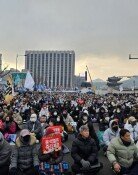Korean Economy Hit Hard by Typhoon Maemi
Korean Economy Hit Hard by Typhoon Maemi
Posted September. 14, 2003 22:49,
▽ Concerns over the economic growth rate falling to 2% level= One thing about the typhoon Maemi is that, not only did it incur loss of lives, it lead to direct damage on the agriculture and other industries on the whole.
In particular, the rice crop yield, which has big influence on the fourth quarter growth rate, is expected record below 30 million rice bags for the first time since 1980 (2465 rice bags), due to heavy rain and lack of sunshine. And with large part of the arable land becoming inundated, the amount of harvested rice is expected to decrease even further.
Damages of container cranes in Shingamman port and Jasungdae port in Busan warn of the possible severe failure in export and import. Containers in the two ports manage 12% of the freight dealt with in Busan. Also, the ceasing of operations in the petrochemical industry, which is connected to other industries, is expected to result in large-scale unseen damages.
Such losses will be lead directly to the fall of the economic growth rate. The Bank of Korea is currently predicting this years growth rate to be 3.1%. However, should rice production record the lowest, the fourth quarter growth rate is expected to fall by 0.5%. It will ultimately drag the overall growth rate by 0.125 percentage point, which could possibly result in a growth rate of 2.9%. Considering the stagnation in other sectors, the situation is even bleaker.
2% level growth rate will be recorded as the lowest in 23 years, except the growth rate of 1998, when the Korean economy recorded minus growth (-6.7%) due to the financial crisis.
Cho Dong-chul, head of Korea Development Institute`s Macro-economy team, said that, ˝agriculture sector represents 5 to 6% of the GDP, and if we consider the seasonal effects around the time of rice harvest, the sector gains an additional 10% importance.˝ Cho Sun-jong, head of the BOK`s Economic Statistics Department, remarked that, ˝the damage of the typhoon Maemi makes it impossible to even guarantee the current yearly estimate growth rate of 3.1%.˝
▽ Could the 2 nd supplementary budget be made? = When the typhoon Rusa inflicted a loss of 5.5 trillion won last year, the government made a supplementary budget of 4.1431 trillion won. More and more people are voicing that supplementary budget is required for this year`s typhoon, which is expected to result in greater damage.
However, the government does not have the resources to spare. Not only has it sold all its share in public companies, the government has already planned a supplementary budget of 4.2 trillion won. Since next year`s budget will only be increased by 1%, the government has to consider the possibility of budget deficit, let alone balanced budget, if it is to set another supplementary budget.
As to prove such concerns, Kim Gwang-lim, vice-minister of the Ministry of Finance and Economy, said that, ˝it is only after calculating the scale of damages, that we could decide on the scale of government support,˝ and added that, ˝but it is not yet time to discuss planning supplementary budget.˝
Another fact is that the government cannot afford to implement expansionary fiscal policy; there is much criticism that the BOK`s decision to lower the interest rate twice has only resulted in the rise of the real estate prices.
Ki-Jeong Ko koh@donga.com
Headline News
- Joint investigation headquarters asks Yoon to appear at the investigation office
- KDIC colonel: Cable ties and hoods to control NEC staff were prepared
- Results of real estate development diverged by accessibility to Gangnam
- New budget proposal reflecting Trump’s demand rejected
- Son Heung-min scores winning corner kick







